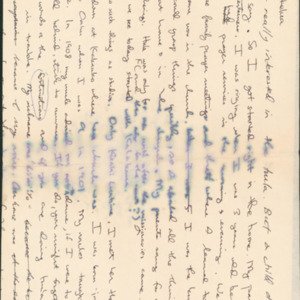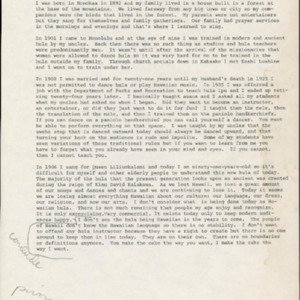Alice Ku‘uleialohapoina‘ole Kanakaoluna Nāmakelua
Title
Alice Ku‘uleialohapoina‘ole Kanakaoluna Nāmakelua
Description
Alice Ku‘uleialohapoina‘ole Kanakaoluna Nāmakelua
Alice Nāmakelua, long recognized as the first lady of the Hawaiian slack-key guitar, retired in 1969 after teaching hula in the Honolulu City and County Department of Parks and Recreation for twenty-four years.
I, Alice Ku‘uleialohapoina‘ole Kanakaoluna, the widow of the late Solomon Nāmakelua Nāhulanui of the island of Hawai‘i, was born on August 12, 1892. I grew up among the men who had survived the battles of Kamehameha to bring the islands under one ruler and some of these survivors were related to my parents and great-grandparents. Some of these men while relaxing would sing and reminisce about their life on the battlefield. These men had documented what they had gone through by putting their experiences into chants and these menfolks were the early dancers in the community. The men would hum a little tune and chant the stories of the battles. The only stringed instrument I saw used was the ‘ūkēkē. There was no such thing as a hālau in our community but one of my family who was pretty good at chanting started teaching a few of us little children to do a few simple dances.
We lived in a lumber house near the bottom of Maunakea mountain faraway from any big town or city, so my companions were the birds by day and the kāhuli in the evenings. My parents were not entertainers but they sang for themselves and family gatherings. Our family had prayer services in the mornings and evenings and that’s when I learned to sing.
In 1899 I moved to Kihalani above Laupāhoehoe where I was trained briefly by my uncle Joseph ʻĪlālā‘ole, in the hula. In 1901 I came to Honolulu and at the age of nine I was trained by my uncles. Back then there was no such thing as a studio and hula teachers were predominantly men. It wasn’t until after the arrival of the missionaries that women were allowed to dance hula so it was very hard for me to be trained in the hula outside my family. Through church socials down in Kaka‘ako I met Keahi Luahine and I went on to train under her. At the age of sixteen I was trained by my last hula instructor David Kaho‘aleawai Kaluhiakalani who served as a chanter for Prince Kūhiō. He advised me not to teach the ancient hula if I should venture out to teach. This is the reason why I’ve never taught the traditional hula. He warned me that if I forgot a single foot movement, hand motion, or word of a chant, I would be breaking a kapu and either myself or my student would physically suffer for it.
In 1908 I was married against my wishes to a boy who was very jealous so I wasn’t permitted to do any dancing or singing for the next twelve years. But in 1945 I was offered a job with the Department of Parks and Recreation to teach hula ipu and I ended up retiring twenty-four years later in 1969. I basically taught ‘auana and I asked all my students what my uncles had asked me when I began. Did they want to become an instructor, an entertainer, or did they just want to do it for fun? I taught them the mele, then the translation of the mele, and then I trained them on cowboy handkerchiefs. If you can dance on a cowboy handkerchief you can call yourself a dancer. You must be able to perform everything on that space. I was taught by my uncles that the ‘uwehe step that is danced outward today should always be danced upward, and that turning your back on the audience is rude and impolite. Some of my students have seen variations of these traditional rules but if you want to learn from me you have to forget what you already have seen in your mind and eyes. If you cannot, then I cannot teach you.
In 1905 at the age of thirteen I started to serve the last ruler of Hawai'i, the Queen Liliʻuokalani, and today I am ninety-two-years- old so it’s difficult for myself and other elderly people to understand this new hula of today. The majority of the hula that the present generation looks upon as ancient was created during the reign of King David Kalākaua. As we lost Hawaiʻi, we lost a great amount of our songs and dances and chants, and we are continuing to lose it. Today it seems we are losing almost everything Hawaiian about our culture; our language, our dress, our religion, and now our arts. I don’t consider what is being done today as Hawaiian hula. There is not much remaining that people my age enjoy and recognize. It is only exercising. It exists today only to keep modern audiences happy.
I don’t see the hula being Hawaiian in the years to come. The people of Hawai‘i don’t know the Hawaiian language so there is no stability. I don’t want to offend any hula instructor because they have a right to create but there is no one around to keep them in line today. They are on their own. There are no boundaries or definitions anymore. You make the cake the way you want, I make the cake the way I want.
Alice Nāmakelua, long recognized as the first lady of the Hawaiian slack-key guitar, retired in 1969 after teaching hula in the Honolulu City and County Department of Parks and Recreation for twenty-four years.
I, Alice Ku‘uleialohapoina‘ole Kanakaoluna, the widow of the late Solomon Nāmakelua Nāhulanui of the island of Hawai‘i, was born on August 12, 1892. I grew up among the men who had survived the battles of Kamehameha to bring the islands under one ruler and some of these survivors were related to my parents and great-grandparents. Some of these men while relaxing would sing and reminisce about their life on the battlefield. These men had documented what they had gone through by putting their experiences into chants and these menfolks were the early dancers in the community. The men would hum a little tune and chant the stories of the battles. The only stringed instrument I saw used was the ‘ūkēkē. There was no such thing as a hālau in our community but one of my family who was pretty good at chanting started teaching a few of us little children to do a few simple dances.
We lived in a lumber house near the bottom of Maunakea mountain faraway from any big town or city, so my companions were the birds by day and the kāhuli in the evenings. My parents were not entertainers but they sang for themselves and family gatherings. Our family had prayer services in the mornings and evenings and that’s when I learned to sing.
In 1899 I moved to Kihalani above Laupāhoehoe where I was trained briefly by my uncle Joseph ʻĪlālā‘ole, in the hula. In 1901 I came to Honolulu and at the age of nine I was trained by my uncles. Back then there was no such thing as a studio and hula teachers were predominantly men. It wasn’t until after the arrival of the missionaries that women were allowed to dance hula so it was very hard for me to be trained in the hula outside my family. Through church socials down in Kaka‘ako I met Keahi Luahine and I went on to train under her. At the age of sixteen I was trained by my last hula instructor David Kaho‘aleawai Kaluhiakalani who served as a chanter for Prince Kūhiō. He advised me not to teach the ancient hula if I should venture out to teach. This is the reason why I’ve never taught the traditional hula. He warned me that if I forgot a single foot movement, hand motion, or word of a chant, I would be breaking a kapu and either myself or my student would physically suffer for it.
In 1908 I was married against my wishes to a boy who was very jealous so I wasn’t permitted to do any dancing or singing for the next twelve years. But in 1945 I was offered a job with the Department of Parks and Recreation to teach hula ipu and I ended up retiring twenty-four years later in 1969. I basically taught ‘auana and I asked all my students what my uncles had asked me when I began. Did they want to become an instructor, an entertainer, or did they just want to do it for fun? I taught them the mele, then the translation of the mele, and then I trained them on cowboy handkerchiefs. If you can dance on a cowboy handkerchief you can call yourself a dancer. You must be able to perform everything on that space. I was taught by my uncles that the ‘uwehe step that is danced outward today should always be danced upward, and that turning your back on the audience is rude and impolite. Some of my students have seen variations of these traditional rules but if you want to learn from me you have to forget what you already have seen in your mind and eyes. If you cannot, then I cannot teach you.
In 1905 at the age of thirteen I started to serve the last ruler of Hawai'i, the Queen Liliʻuokalani, and today I am ninety-two-years- old so it’s difficult for myself and other elderly people to understand this new hula of today. The majority of the hula that the present generation looks upon as ancient was created during the reign of King David Kalākaua. As we lost Hawaiʻi, we lost a great amount of our songs and dances and chants, and we are continuing to lose it. Today it seems we are losing almost everything Hawaiian about our culture; our language, our dress, our religion, and now our arts. I don’t consider what is being done today as Hawaiian hula. There is not much remaining that people my age enjoy and recognize. It is only exercising. It exists today only to keep modern audiences happy.
I don’t see the hula being Hawaiian in the years to come. The people of Hawai‘i don’t know the Hawaiian language so there is no stability. I don’t want to offend any hula instructor because they have a right to create but there is no one around to keep them in line today. They are on their own. There are no boundaries or definitions anymore. You make the cake the way you want, I make the cake the way I want.
Citation
“Alice Ku‘uleialohapoina‘ole Kanakaoluna Nāmakelua,” Nā Kumu Hula Archive, accessed November 28, 2025, https://nakumuhula.org/archive/items/show/74.




